My beardie is upset with me because I haven’t fed him yet. He is hissing at me and the spiked beard under his chin is puffed up. But I also noticed his tail, it looks dark. Does my pet lizard have bearded dragon tail rot? Oh no! what should I do? Did I do something wrong in his care?
Will it harm my beardie? A tail rot disease in bearded dragons can start out mild but will quickly turn worse. Even though tail rot is commonly identified with a lizard’s tail, it can also affect their toes.
Just as an important fact, tail rot ailment on their toes, the symptoms are nearly the same as tail rot on the tail area. When the blood circulation is cut off in your bearded dragon’s toes. Yes, they will also turn black and fall off.
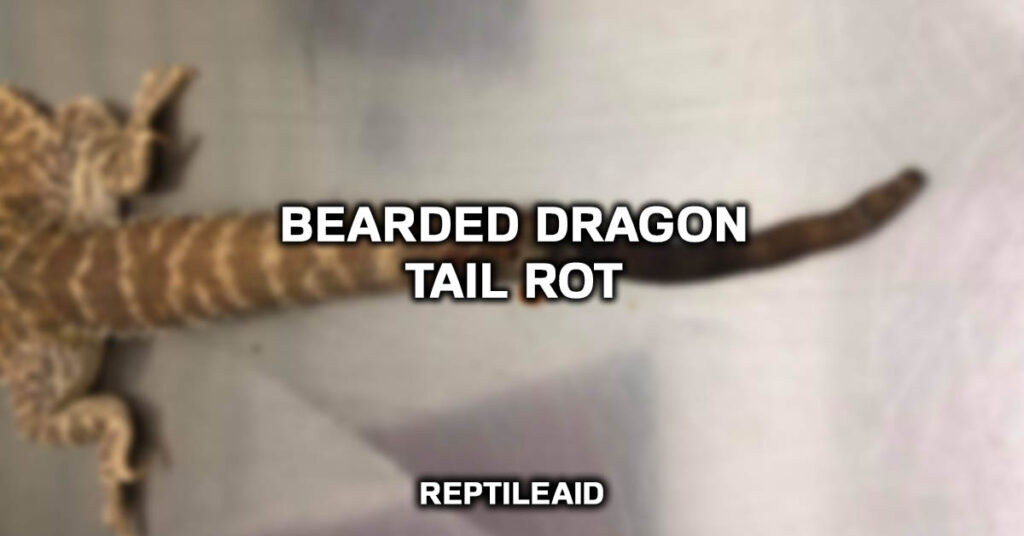
Symptoms of Tail Rot
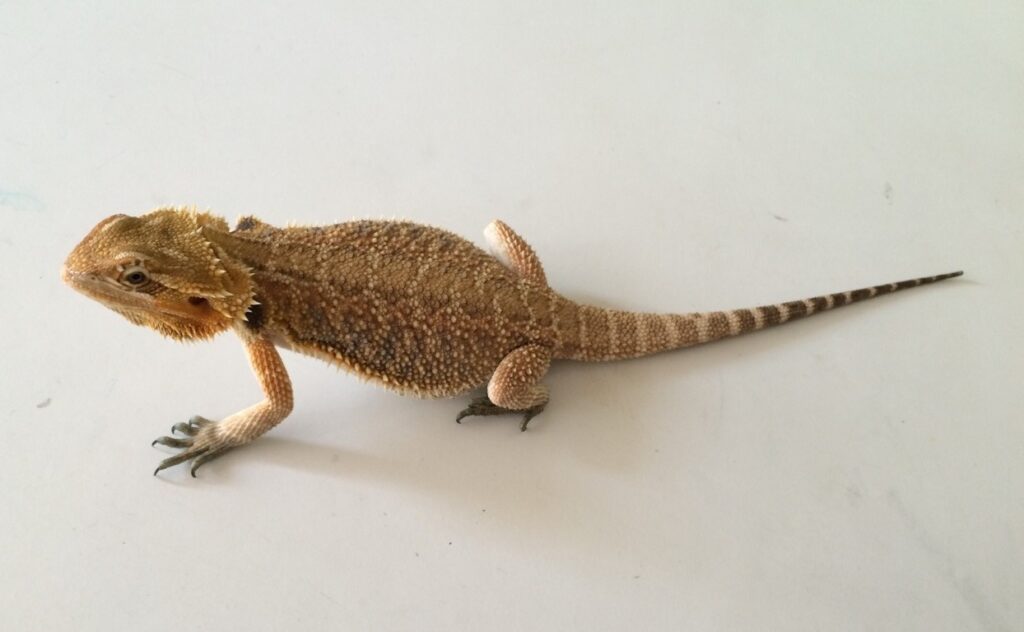
Tail Rot in a bearded lizard is a necrotic condition. It happens when part of a lizard’s tail no longer is receiving the proper blood supply. When this happens the lizard’s tail will turn a dark blue, black, or purple coloring.
Expert Tip: If your beardies tail is lighter in color (greyish) than the rest of the tail, then your bearded dragon may be in a shed or molting period. But if the tail is darker than it has been then it could be tail rot.
In tail rot diseases, there are several physical and behavioral symptoms that you will notice in your bearded dragon. To start with and as previously stated, there is a featured tail discoloration. The tail discoloration usually starts at the tip of its tail.
Let’s talk about the natural appearance of your bearded dragon. If your pet lizard has a naturally dark tail area, don’t confuse this with tail rot.
Check with your vet to make sure. However, if your beardie suddenly develops a very dark area around its tail and it is moving up closer to its body take immediate remedial action.
Tail rot in beardies is also a noticeable ailment. A bearded dragon’s tail is normally flexible. You can tell when you hold them. However, a tail rot disease makes their tail become stiff, angled, as well as slightly twisted or kinked.
Other symptoms of tail rot include the beardies’ skin texture. The bearded dragon’s skin will turn very coarse, flaky, brittle, and drier than its normal relatively smooth skin texture.
Additional behavioral symptoms include:
- Swelling in the tail area.
- Aggressiveness is like attempting to bite you because they are in pain.
- Loss of appetite. Not even their favorite feeder insect food is appealing to them
- Your bearded will suddenly want to hide within their enclosure.
- Lethargy or just lying around without much movement. This is very unlike bearded dragons.
- A rising body temperature – 40 degrees centigrade.
A watchful bearded dragon owner can tell even with the subtleties of their habits and appearances.
How Dangerous Is Tail Rot to Beardies
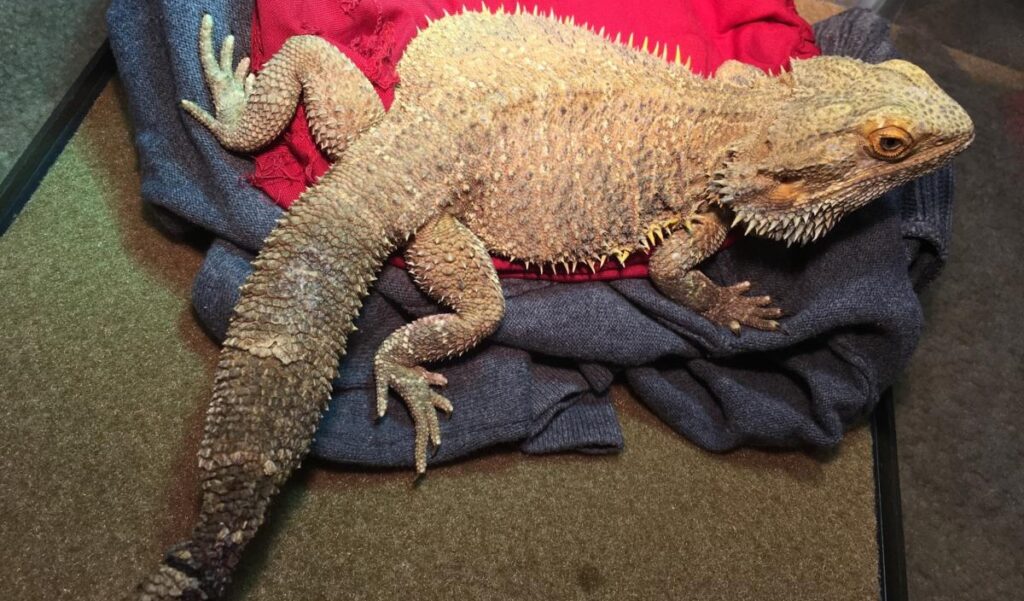
This symptom must be treated immediately. New bearded dragon owners may not notice this ailment until it has turned into a very serious problem, or the tail has actually fallen off. Normally, lizards have natural breakpoints in their vertebrae system and the tail is one of them.
Once a necrotic tissue dies, bacteria and decay begin to spread into the surrounding muscle and tissue, causing it to die. But even when your beardies’ tail or part of its tail detaches from its body there is no blood loss or body trauma to them. However, the loss of a beardies tail due to tail rot the infection can still be in their body, and it must be treated.
Yes, tail rot is dangerous for your bearded dragon tail to rot due to its possible fatal outcome.
If there is any delay in providing help to your beardie then his tail or part of its tail can fall off. Also, an infection that caused tail rot could result in traveling through its body causing your bearded dragon to pass away.
Causes of Tail Rot
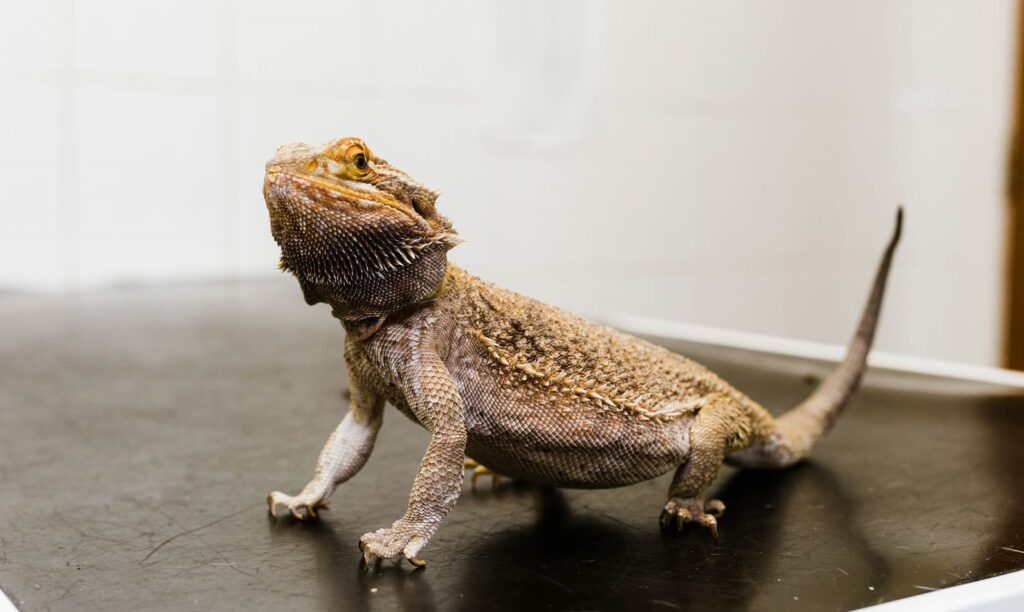
As a bearded lizard pet owner, don’t fret. You may not have done anything to cause this harmful ailment. There are several causes for a bearded dragon to develop tail rot. Commonly, bearded dragon tail rot is caused by either an infection or trauma.
When the cause is a trauma, resulting in affection, there are several causes that could cause tail rot. Let’s look at some of the reasons for tail rot:
- Do you have another bearded lizard in the same cage? Bearded dragons are known to be territorial in nature, thus causing a fight.
- Do you have one male and a female? During the mating season, before a little beardie is produced, the courting may be a little on the rough side. Either way, a bearded dragon’s tail may receive a bite or a scratch that is left unattended. As a result, the tail can become infected.
- Is your beardie receiving sufficient nutritious foods? Is your bearded dragon receiving the right amount of minerals and vitamins, especially calcium? Poor nutrition results in the formation of infections and illnesses, especially involving tail rot.
- Lizard shed is a natural skin-shedding occurrence. If they do not shed properly, part of the shedding process could cause dead skin to remain on the lizard’s tail. This can cut off its tail’s blood supply and cause an infection.
- Since bearded dragons are very active, they use their tails to climb, run, and balance. They can easily injure their tails by falling on them in their bustling activities.
It is not always instantly clear what causes tail rot in lizards. For example, other causes of bearded dragon tail rot could result from a blood clot in the tail, parasites, or a fungus. But if you see any abnormalities in your bearded dragon, contact your vet for the right diagnosis and treatment.
How To Prevent Tail Rot
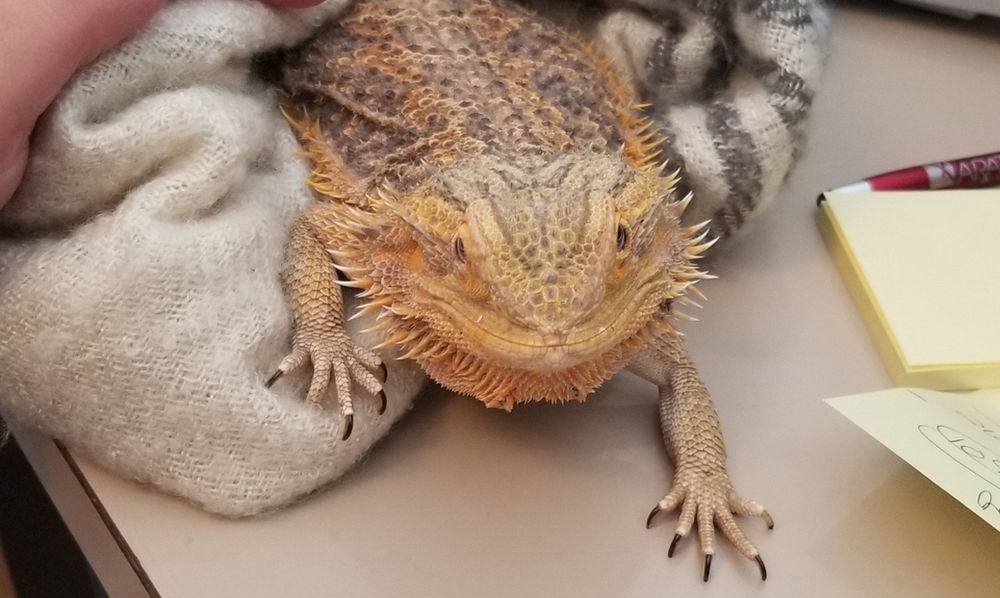
The best actions to take to prevent tail rot are preventative solutions. When you take preemptive care, your pet bearded dragon will live a happier and healthier life. One such preventative solution is in the lighting environment you provide for your beardie. Believe it or not, the right UVA/UVB lighting environment helps prevent tail rot.
Just supplying the right lighting environment will protect your lizard’s tail. In nature bearded dragons know how to receive all the lighting they need.
However, as domestic pets, beardies depend on their owners for all the right environmental requirements. The right UVB lighting through photosynthesis supplies the right amount of calcium for your beardie in growing strong bones and other life-sustaining concerns.
Expert Tip: Another prevention method for tail rot starts with providing your bearded dragon with the right amount of enclosure space. Don’t forget that beardies grow quickly.
Ensure that your enclosure is enlarged as they grow. Also, watch your beardie to keep it safe from any loose objects or sharp objects that could harm your lizard. These preventive measures help a great deal to take good care of your bearded dragon. Naturally, there are two outset measures that will help to prevent tail rot.
First, as a new pet lizard owner is to make sure that your pet comes from a responsible breeder, meaning that your beardie will not be prone to illnesses. It is also important to note that tail rot is not contagious because of the problem that causes its effect is an internal event. Secondly, keep your bearded dragon clean and well-maintained.
Just remember that the best preventive measure to ward off tail rot is to keep their enclosure clean and to keep it safe from harmful bacteria environment.
Treating Tail Rot at Home – Part One
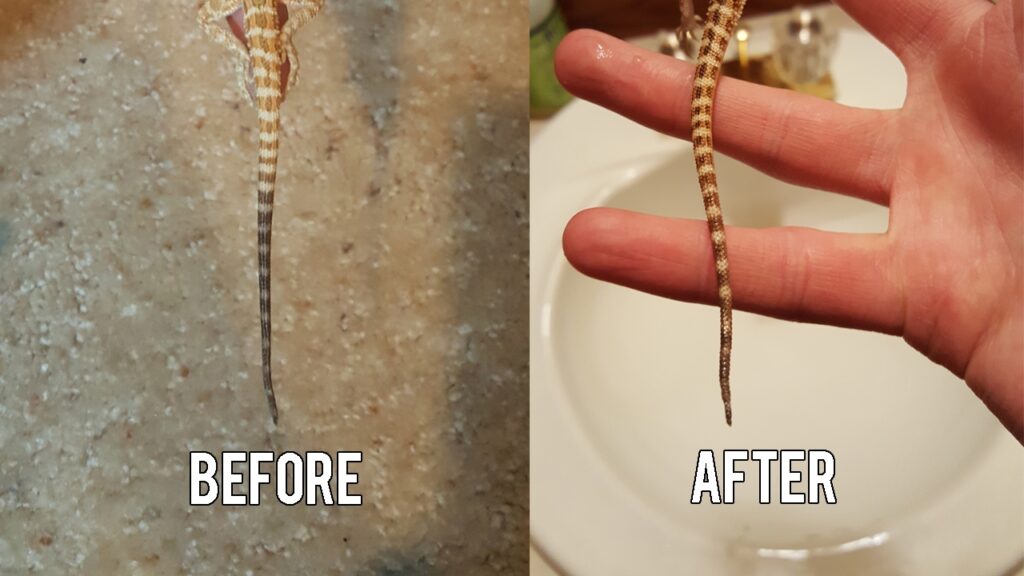
Naturally, a veterinarian should be contacted as soon as possible for your bearded dragon to address its tail rot condition. As we have seen, tail rot is a dangerous, progressive, and degenerative condition.
If caught in time, a vet will supply antibiotics and other medications to save your beardies’ tail and improve its overall health. If tail rot is not caught in time, the vet may suggest amputation of part of its tail.
However, if you are treating your bearded dragon at home, there are succinct steps you can take, as you also consult with your vet.
Yes, there are home remedies that beardie owners can use to save their lizard from losing its tail. Here is a tail rot recipe that has been proven to work:
- First, gently clean the tail in lukewarm water before applying your treatment.
- Mix thoroughly 3 parts of warm water (around 80-to-85 degrees Fahrenheit) with 1 part of an antiseptic or anti-bacterial solution (recommended by a vet).
- Somehow with all the squirming, place only the affected tail directly into this liquid.
- Good luck in submerging the tail there for around 5 minutes to thoroughly soak up the anti-bacterial solution.
- Use a soft paper towel or soft cloth to pat dry the affected tail area. Remember to be very ginger about touching your beardie’s tail because they are probably in pain, plus the tail is highly fragile.
- Next place some antibiotic ointment (recommended by a vet) onto the affected area. Your vet will very likely suggest that you don’t use any anti-biotic solutions that are used to treat pain. Pain-free solutions are too harsh and strong for reptiles.
- (Also, your vet will inform you to keep your beardie hydrated inwardly and outwardly. Soaking a beardie’s tail for more than 3 days can cause it to become dry which only worsens the tail rot situation. Keeping beardie hydrated inside will keep their kidneys functioning properly.)
- Readdress the anti-bacterial procedure every day. at least twice a day for at least a week. Longer if your vet suggests.
Treating Tail Rot at Home – Part Two
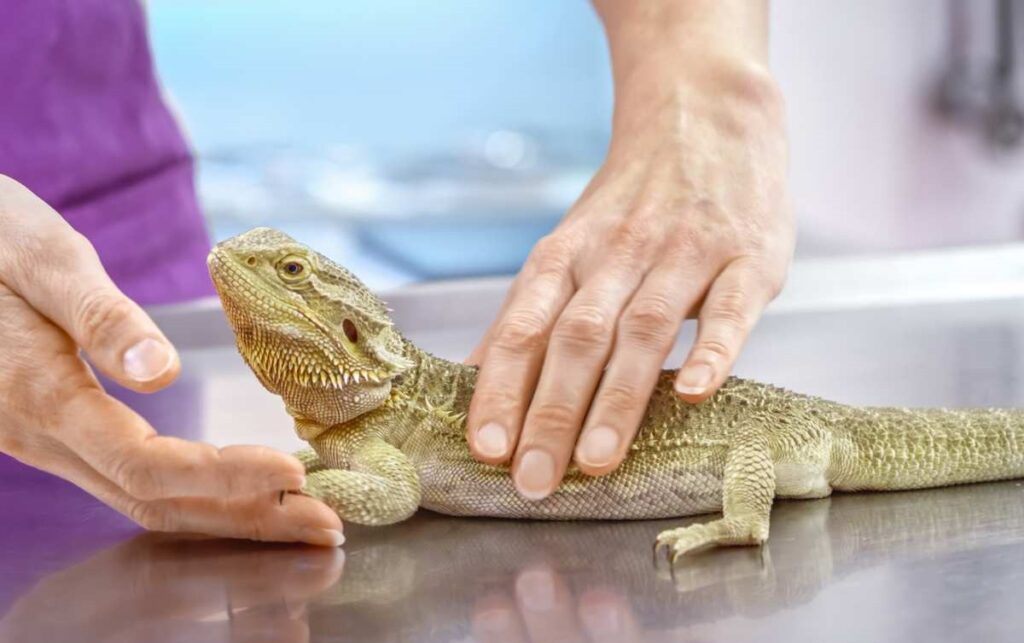
Now, while you are treating your beardies’ tail rot condition, just as a matter of caution, you should reclean their enclosure (aquarium, terrarium, or a do-it-yourself cage). A clean enclosure helps to improve healing and as a precaution, it helps to prevent other types of infections.
Temporarily, place your beardie into an enclosure with a clean and porous substrate. Also, keep the right temperature for their happiness and health.
Even when placing beardies in a short-term enclosure cold-blooded reptile bearded dragons still need a temperature gradient to keep their body temperature regulated. This is especially important when they are fighting infections like tail rot.
Before you put your beardie back into its original enclosure, discard all of the old substrate and objects of fun and play from the original enclosure. Clean all objects with hot soapy water.
Disinfect the enclosure with over-the-counter pet store solutions or with a diluted bleach solution.
To prevent introducing mold or mildew into a beardies’ enclosure, everything about the enclosure must be dry, dry, dry before you reintroduce your beardie back into the enclosure.
Watch how long you are DIY treating your bearded dragon’s tail rot and whether its health is improving.
If you are entering week two and there are no progressive changes in the condition of your bearded dragon’s tail, immediately contact your local vet for further professional hands-on or virtual treatments.
Tail rot as we can see is a life-threatening condition that should be treated as quickly as possible. Your beloved bearded dragon depends on you to keep them happy, well-fed, and enjoying life as your domestic pet.
Expert Tip: Keep an eye open for physical and emotional changes in their health like the possibility of tail rot. Your very active and friendly bearded dragon will let you know when something is wrong
.
How to Treat Reptile Tail Rot
Reptile tail rot is a serious condition. It can cause literally make the tail become rotten. Tail rot, if left untreated can cause serious damage to your pet and worst can lead to its death. There are several ways how to treat a reptile’s tail rot. Though, it can be treated through careful procedure. So, how do you treat reptile tail rot?
If reptile tail rot is suspected on your pet, you should consider looking and engaging in the possible treatment. To treat a tail rot you need a large bucket of lukewarm water enough to fully submerged the reptile without drowning it. Then for every ten parts of the water, you must add one part of betadine.
Next is to put the reptile inside then cover the bucket with a lid with poked holes in it. Let the reptile be soaked in it for half an hour, then rinse it and let it dry with a towel. With this procedure, the reptile tail rot will be treated in no time.
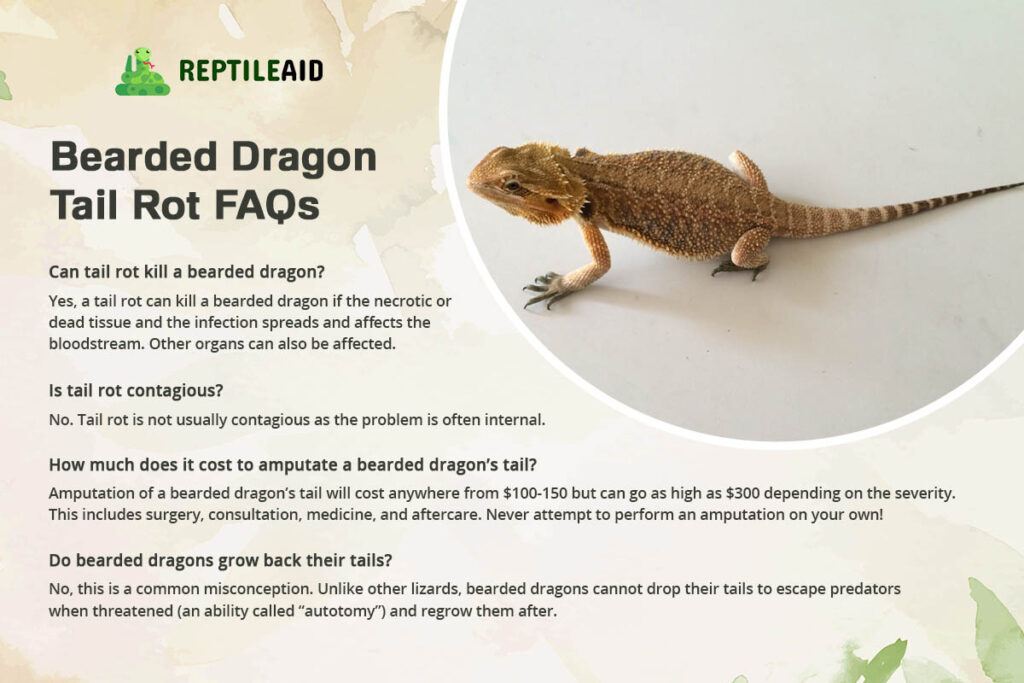
Conclusion
Your bearded dragon’s existence is a constant watch for pet owners. A bearded dragon tail rot situation can be frightening but there is hope for a full recovery. Just remember, that a bearded dragon’s tail does not grow back like the leopard gecko!
Create a daily schedule for making sure your bearded dragon remains healthy and happy. Granted that tail rot on your beard is not a panacea situation but taking immediate action will give your beardie a long and happy life.
If you have any questions or comments, contact me, and let me know what you think. I am happy to help you keep your bearded dragon the fun pet that they are known to be.
